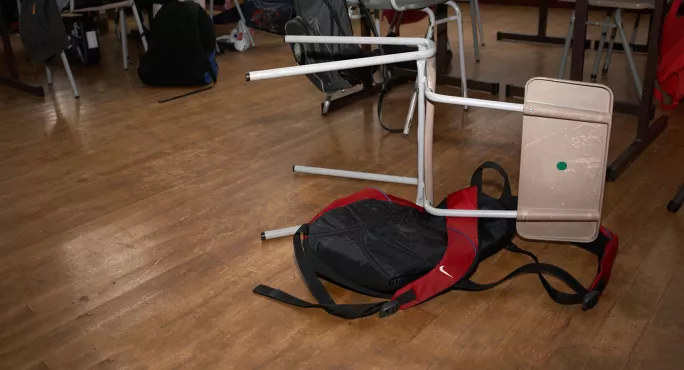Behaviour tsar hits out at bid to ban isolation rooms

Sending children to “isolation booths” in schools should be banned until a system is in place to monitor their use, according to the British Psychological Society.
The society has called on the government to introduce regulation to oversee the use of isolation rooms in schools “to protect the rights and interests of all children and their families”.
However, its call for a ban has been strongly criticised by the Department for Education’s lead behaviour adviser, Tom Bennett, who described it as “the kind of advice that leads to schools being violent and unsafe for staff and students”.
Behaviour in schools: Call for clearer guidance on the use of isolation booths
Opinion: Six ways isolation booths can be used effectively
Controversy: Hundreds of pupils spend week in booths, investigation finds
The British Psychological Society has said that the use of isolation booths is not backed by evidence and has been proven not to be effective, and adds that such approaches to children’s behaviour are overly simplistic and “run counter to the understanding of child development”.
However, it then also goes on to acknowledge “that in some extreme circumstances the use of isolation rooms/booths can be used for pupil and teacher safety”.
In a statement, it added: “Each school is different, and decisions must be taken on a case-by-case basis. However, to protect the rights and interests of all children and their families, the BPS feels there needs to be regulation and monitoring of the use of these provisions in schools.
“Furthermore, the BPS would also encourage schools to avoid the use of isolation/segregation when and where possible.”
Behaviour: Controversy over the use of isolation rooms in schools
Vivian Hill, vice-chair of the British Psychological Society’s division of education and child psychology, said: “The use of isolation rooms breaches the UN convention on the rights of the child, denying them their right to learn effectively, and disproportionately affects those children and young people who need the most support.
“This includes children with disabilities and special educational needs, those living in poverty, children in care, boys from black and mixed backgrounds and children already experiencing lower levels of emotional or psychological wellbeing.
“The use of isolation booths locates ‘the problem’ within the child and fails to recognise the links between disability special education needs, poverty, inequality, lower wellbeing, poor mental health and children’s behaviour in school.
“We need to see a cultural shift on how schools support vulnerable children, focusing on building supportive environments for our children within schools and colleges, encouraging creativity, teaching social-emotional skills and autonomy, and a strong sense of school belonging to promote positive behaviour in children and young people.”
‘They’re not isolation booths’
However, Mr Bennett has criticised the society’s position.
1. They’re not ‘isolation booths’ they’re rooms, supervised by staff, where children are temporarily taken when their behaviour is unsustainable in a classroom. This includes, violence, threats, intimidation, abuse, racism etc.
- Tom Bennett (@tombennett71) October 27, 2021
In a post on Twitter, he said: “This is irresponsible and heavily ideological advocacy by a group that should know better. This is the kind of advice that leads to schools being violent and unsafe for staff and students.
In a thread on the social media site, Mr Bennett also took issue with the use of the term “isolation booths”.
He said: “They’re not ‘isolation booths’, they’re rooms, supervised by staff, where children are temporarily taken when their behaviour is unsustainable in a classroom. This includes violence, threats, intimidation, abuse, racism, etc.
“If you don’t remove students when they do this, you’re expecting children and staff to put up with it: intimidation, threat, violence, etc. My response is always, ‘Would you expect your child to endure that kind of toxic hell?’ Of course not. It’s always someone else’s kids
“Because for people who advocate against removal processes, it’s never something they have to deal with. It’s a hypothetical. It’s a thought exercise; a puzzle. Not a room they have to spend all day in. Again: ‘Someone else’s children can put up with this, not me or mine.’
“Children frequently need to be removed for their safety and wellbeing, too - eg, sometimes when they have a meltdown or a crisis. Do you really think a classroom is the right place to do this? And does the education of everyone else not matter? Why not?
“In many schools, removal leads to a place of respite and calm, away from the triggers that inspire their outbursts. Their bodies can calm down in peace.
“Every student is entitled to uninterrupted education, so children must continue to receive this even when removed. Work must be provided, and support given. Whether they are emotionally capable of engaging with it or not at that moment. Every child matters.
“Claiming that removal denies them their UN guarantee rights is ridiculous. Keeping hostile aggressors in the same rooms as their victims is far more ruinous for the rights, liberties and dignity of all.”
A Department for Education spokesperson said: “Every school should be a calm and respectful environment, where all pupils and staff feel safe, and where all children and young people can learn, thrive, and reach their potential.
“Schools can adopt a policy where disruptive pupils are placed away from others for a limited period. Our guidance is clear that in doing so schools must comply with pupil welfare and safeguarding requirements.”
You need a Tes subscription to read this article
Subscribe now to read this article and get other subscriber-only content:
- Unlimited access to all Tes magazine content
- Exclusive subscriber-only stories
- Award-winning email newsletters
Already a subscriber? Log in
You need a subscription to read this article
Subscribe now to read this article and get other subscriber-only content, including:
- Unlimited access to all Tes magazine content
- Exclusive subscriber-only stories
- Award-winning email newsletters
topics in this article




